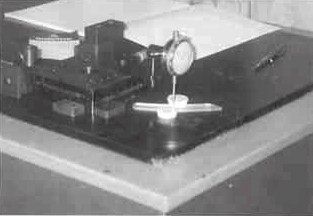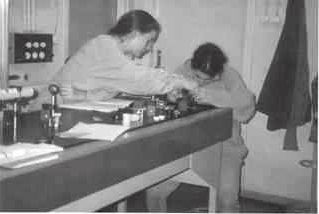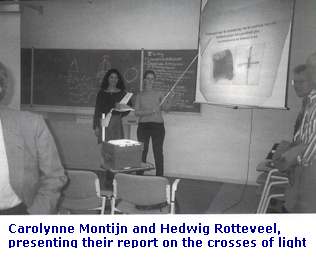Crosses of light under scientific scrutiny
by
Ineke Hommes
Delft, The Netherlands
Share International holds the view that the method of manifestation
of the crosses of light in glass windows is a mystery known only to Maitreya
Himself and that it cannot be proved one way or another by present-day
science. However, the following attempts by young physics students might
be of interest to our readers.
Since their first appearance in Los Angeles in May 1988, several hundred
more crosses of light have miraculously appeared in people's homes all
over the world. From America to New Zealand, from the Philippines to Slovenia,
brilliant crosses of light have sometimes appeared in the frosted glass
windows of houses, hospitals and churches, when a one-pointed light source
shines through the glass from the other side. Witnesses call them miracles
and report healings, others travel hundreds of miles just to enjoy their
beauty.
In the extensive media coverage about the mysterious crosses over the
past 10 years, scientists have been asked their opinion about the 'inexplicable
phenomenon'. Occasionally, this resulted in a brief examination of a window
and even briefer comments (which usually refer to 'the special structure
of the glass', 'dirt accumulation' or 'atmospheric influences'). Other
than that, the crosses of light have never been thoroughly investigated
by the scientific community.
 In
the last year, however, a more elaborate study has been carried out. At
the Dutch Technical University of Delft, two third-year students, Carolynne
Montijn and Hedwig Rotteveel, from the faculty of Technical Physics, have
spent over 10 months on their 'cross of light research project'. The subject
was presented to them by their physics teacher. He had been interviewed
for a science magazine in connection with 'modern-day miracles' and had
become intrigued by the crosses of light, for which he had no immediate
explanation.
In
the last year, however, a more elaborate study has been carried out. At
the Dutch Technical University of Delft, two third-year students, Carolynne
Montijn and Hedwig Rotteveel, from the faculty of Technical Physics, have
spent over 10 months on their 'cross of light research project'. The subject
was presented to them by their physics teacher. He had been interviewed
for a science magazine in connection with 'modern-day miracles' and had
become intrigued by the crosses of light, for which he had no immediate
explanation.
Hedwig: "It seemed like a great challenge, especially since we appeared
to be the first to try and explain this phenomenon from within the science
lab. At the same time, that was also our problem: there was hardly any
scientific data to fall back on, so we had to start from scratch. For
our initial research we began by simply calling up libraries and bookstores
to see if there was any literature on the subject. It turned out there
was a recently published book called Signs of a new time? by Dutch
author Richard Bremer. It describes occurrences of the crosses of light,
crying Madonnas, crop circles and numerous other miracles taking place
around the world. We had no idea all these things were happening on such
a scale, or that any books had been written about them.
"Secondly, we searched the internet, typed in 'cross of light' and
discovered websites from Share International and media reports on the
subject. Also, we found a videotape about the crosses made by American
film editor Frances Robinson. Last, and most important, we had the opportunity
to borrow a small piece of frosted glass that was cut from a window in
Canada some years back which clearly shows a red cross of light. It was
all we had to go on, but it turned out to be just enough for our purposes.
"We read about the theories that the crosses must be signs of some
great spiritual happening in the world, but even if that were so, we thought
the form of the crosses in the glass should still be scientifically explainable.
So we set out to try and prove that."
Computer simulation
"Our goal," Carolynne continues, "was not to establish
the cause of the overnight change in the windows, but to find out exactly
how glass can show
such particular patterns at all.
 "We
wrote three different computer programmes which simulate the refraction
pattern (the way in which the light bends when going through the glass)
through a pre-programmed three-dimensional object. We then measured the
surface profile of two pieces of frosted glass: one regular piece showing
the usual pillow-like shape (when light shines through it), and the Canadian
piece with the cross. We determined the refractive index of the glass
based on the piece of glass showing the pillow pattern. Using a specific
mathematical method, we calculated a polynomial function which describes
the surface profile. These functions in turn were processed into another
simulation programme using the same theory based on the assumption that
the refractive patterns derive from a 'simple' refractivity (based on
Snell's laws of refraction). Apart from that, we wrote a third - control
- programme using measurements without this mathematical method. What
we tried to do was to find out if there was a specific index of refraction
which produces the cross form."
"We
wrote three different computer programmes which simulate the refraction
pattern (the way in which the light bends when going through the glass)
through a pre-programmed three-dimensional object. We then measured the
surface profile of two pieces of frosted glass: one regular piece showing
the usual pillow-like shape (when light shines through it), and the Canadian
piece with the cross. We determined the refractive index of the glass
based on the piece of glass showing the pillow pattern. Using a specific
mathematical method, we calculated a polynomial function which describes
the surface profile. These functions in turn were processed into another
simulation programme using the same theory based on the assumption that
the refractive patterns derive from a 'simple' refractivity (based on
Snell's laws of refraction). Apart from that, we wrote a third - control
- programme using measurements without this mathematical method. What
we tried to do was to find out if there was a specific index of refraction
which produces the cross form."
Identical cross
"The results were quite amazing," says Hedwig. In their 110-page
report, presented at Delft University in 1998, they conclude that their
computer
programme indeed provides a good replica of crosses of light. "Our
simulation so much resembles reality that both form and size of the refractive
pattern look identical to the actual cross. In other words: we have been
able to simulate the cross in the smallest detail. Our conclusion is that
the change from the normal form into the figure of a cross can be attributed
to a change in the refractive index of the surface of frosted glass to
exactly 1.561. So, as soon as light bends through glass with a refractive
index of this exact number, it displays the form of a cross."
 "Of
course," says Carolynne, "for the sudden alteration of the shape
in a window to occur, the surface of the glass somehow must have changed.
As the crosses appear all around the world, it is highly unlikely that
the abrupt transformation of the pattern has to do with the kind of glass
used or the manufacturing process. We had this confirmed by a local glass
company.
"Of
course," says Carolynne, "for the sudden alteration of the shape
in a window to occur, the surface of the glass somehow must have changed.
As the crosses appear all around the world, it is highly unlikely that
the abrupt transformation of the pattern has to do with the kind of glass
used or the manufacturing process. We had this confirmed by a local glass
company.
Therefore,
although from the point of view of physics we have successfully demonstrated
that when the light bends through frosted glass under a specific index
of refraction, this particular form of a cross is seen, further research
would be necessary into the actual cause of this strange phenomenon. Perhaps
it would have to do with minute changes in the surface of the glass, caused,
for example, by rigorous cleaning; or, theoretically, the molecular structure
of the cross-windows somehow having been altered. To our minds, for this
part of the puzzle there must be an equally viable scientific explanation."
PHOTO CAPTIONS:
In order to measure the surface of the glass and thereby the refraction
pattern, the Dutch students used an altimeter and a tiny metal pin. The
pin scans the surface of the frosted glass, whose structure, when looked
at closely, in this case consists of rows of tiny pyramids. They measured
the differences in height of the pyramids in order to determine the refractive
index of the glass in any particular spot. The piece of glass was held
in place with magnets on a vibrationless metal table.
Source: Share International
from: Share International January/February 1999
Reprinted courtesy of © Share
International
| Top of the Page |
|